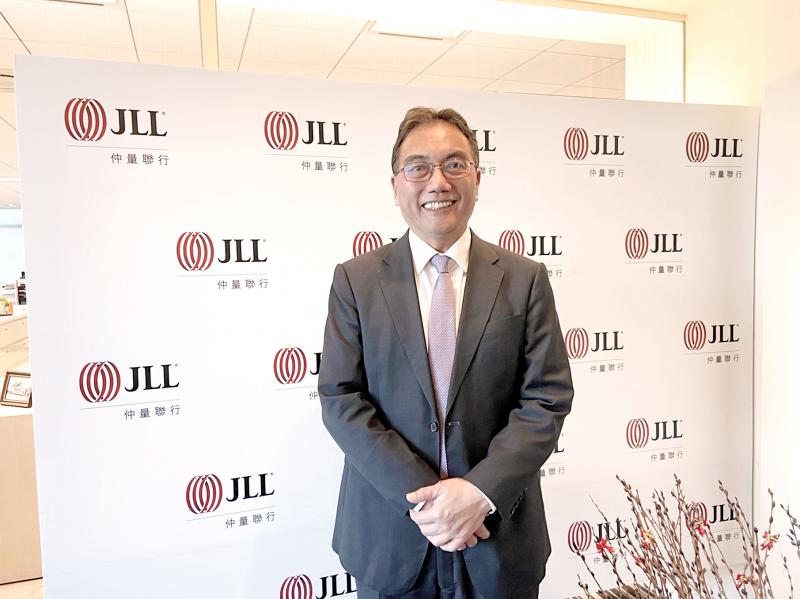The commercial property market could see another boom after soaring 56 percent to NT$149.5 billion (US$5.26 billion) last year, driven by strong demand for industrial and office spaces, as well as government-backed urban renewal projects, Jones Lang LaSalle Inc (JLL) said on Tuesday.
Government-backed development projects near Taipei Railway Station, Taiwan Power Co’s (台電) former office in Taipei’s Nangang District (南港) and Kaohsiung’s “Asia New Bay Area” (亞洲新灣區) could hit NT$190 billion or higher this year, JLL Taiwan managing director Tony Chao (趙正義) told a news briefing in Taipei.
The tender offers are likely to draw close attention given limited land supply in popular locations across the nation, Chao said.

Photo: Hsu Yi-ping, Taipei Times
Commercial property deals could reach NT$100 billion this year, and land transactions could surpass NT$200 billion, he said.
Land deals, including superfices rights, amounted to NT$287.5 billion last year, JLL Taiwan said, adding that residential plots underpinned 56 percent, as developers aggressively built land inventories, notably in New Taipei City and Taichung.
Tainan also attracted heavy property funds after Taiwan Semiconductor Manufacturing Co (TSMC,台積電), the world’s largest contract chipmaker, announced plans to set up new plants in the area, JLL Taiwan said.
TSMC’s suppliers would soon follow suit and the cluster effect would spur demand for residential spaces, Chao said.
Some tech firms have teamed up with builders to develop residential complexes, and the market might see more such collaborations, he said.
In related news, vacancy rates for grade A offices in Taipei edged up 0.1 percent to 2.16 percent last quarter, while rents grew a fractional 0.6 percent, JLL Taiwan said.
The mild increase in vacancy rates came because some firms relocated to make way for other corporate tenants to earn rental income, JLL Taiwan said.
The office market remains tight, and companies with space to spare are leasing it to make money, the consultancy said.

UNCERTAINTY: Innolux activated a stringent supply chain management mechanism, as it did during the COVID-19 pandemic, to ensure optimal inventory levels for customers Flat-panel display makers AUO Corp (友達) and Innolux Corp (群創) yesterday said that about 12 to 20 percent of their display business is at risk of potential US tariffs and that they would relocate production or shipment destinations to mitigate the levies’ effects. US tariffs would have a direct impact of US$200 million on AUO’s revenue, company chairman Paul Peng (彭雙浪) told reporters on the sidelines of the Touch Taiwan trade show in Taipei yesterday. That would make up about 12 percent of the company’s overall revenue. To cope with the tariff uncertainty, AUO plans to allocate its production to manufacturing facilities in

TAKING STOCK: A Taiwanese cookware firm in Vietnam urged customers to assess inventory or place orders early so shipments can reach the US while tariffs are paused Taiwanese businesses in Vietnam are exploring alternatives after the White House imposed a 46 percent import duty on Vietnamese goods, following US President Donald Trump’s announcement of “reciprocal” tariffs on the US’ trading partners. Lo Shih-liang (羅世良), chairman of Brico Industry Co (裕茂工業), a Taiwanese company that manufactures cast iron cookware and stove components in Vietnam, said that more than 40 percent of his business was tied to the US market, describing the constant US policy shifts as an emotional roller coaster. “I work during the day and stay up all night watching the news. I’ve been following US news until 3am

COLLABORATION: Given Taiwan’s key position in global supply chains, the US firm is discussing strategies with local partners and clients to deal with global uncertainties Advanced Micro Devices Inc (AMD) yesterday said it is meeting with local ecosystem partners, including Taiwan Semiconductor Manufacturing Co (TSMC, 台積電), to discuss strategies, including long-term manufacturing, to navigate uncertainties such as US tariffs, as Taiwan occupies an important position in global supply chains. AMD chief executive officer Lisa Su (蘇姿丰) told reporters that Taiwan is an important part of the chip designer’s ecosystem and she is discussing with partners and customers in Taiwan to forge strong collaborations on different areas during this critical period. AMD has just become the first artificial-intelligence (AI) server chip customer of TSMC to utilize its advanced

Six years ago, LVMH’s billionaire CEO Bernard Arnault and US President Donald Trump cut the blue ribbon on a factory in rural Texas that would make designer handbags for Louis Vuitton, one of the world’s best-known luxury brands. However, since the high-profile opening, the factory has faced a host of problems limiting production, 11 former Louis Vuitton employees said. The site has consistently ranked among the worst-performing for Louis Vuitton globally, “significantly” underperforming other facilities, said three former Louis Vuitton workers and a senior industry source, who cited internal rankings shared with staff. The plant’s problems — which have not